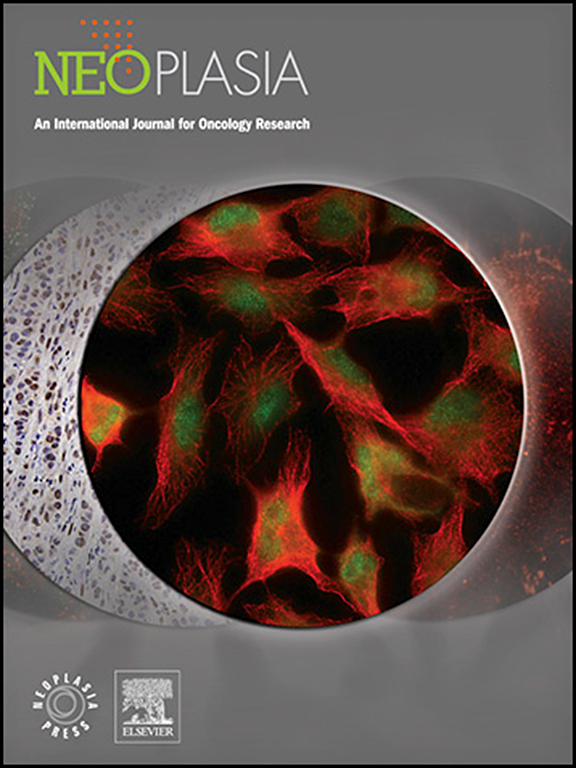β-Catenin介导的TAM表型通过OSM/STAT3/LOXL2轴促进胰腺癌转移。
IF 4.8
2区 医学
Q1 Biochemistry, Genetics and Molecular Biology
引用次数: 0
摘要
胰腺导管腺癌(Pancreatic ductal adencarcinoma, PDAC)具有侵袭性和预后差的特点,这主要归因于其独特的肿瘤微环境。然而,肿瘤相关巨噬细胞(TAM)促进PDAC进展的分子机制,特别是β-catenin信号在调节TAM表型和功能中的作用,仍然不完全清楚。首先,我们对RNA-seq和单细胞RNA-seq (scRNA-seq)数据集进行了综合分析,以研究PDAC中OSM和LOXL2的表达模式。随后,利用thp -1来源的巨噬细胞检测β-catenin和OSM在tam中的调节关系。此外,通过体外共培养系统和体内Panc02肺转移模型,评估tam衍生的OSM对PDAC进展的功能影响。此外,机制研究采用药物抑制剂和遗传方法靶向β-catenin、OSM和STAT3信号。值得注意的是,PDAC标本中OSM和LOXL2的表达升高与患者生存不良显著相关。有趣的是,scRNA-seq分析显示,免疫细胞中β-catenin信号在TAM中被唯一激活,从而调节TAM极化和OSM表达。这些表达osm的tam表现出明显的M1/M2杂交表型。此外,我们对tam的转录谱分析显示,促炎和抗炎程序同时激活,并富集Wnt信号通路。暴露于tam衍生因子的PDAC细胞的RNA-seq分析显示,间质转化和干性特性增强,OSM信号和细胞外基质重塑途径直接富集。机制上,β-catenin激活直接调节TAM表型和OSM表达,而TAM条件培养基促进PDAC细胞迁移、侵袭和肺转移。重要的是,抑制β-catenin信号同时改变TAM极化和降低OSM表达,从而显著减弱共培养PDAC细胞的上皮-间质转化(EMT)。此外,STAT3抑制消除了osm诱导的LOXL2表达和随后的EMT编程。总之,我们发现了一个新的β-catenin/OSM-STAT3/LOXL2信号轴介导tam诱导的PDAC进展。这一途径不仅阐明了β-catenin介导的TAM功能和表型调节机制,而且为干预提供了潜在的治疗靶点。本文章由计算机程序翻译,如有差异,请以英文原文为准。
β-Catenin mediated TAM phenotype promotes pancreatic cancer metastasis via the OSM/STAT3/LOXL2 axis
Pancreatic ductal adenocarcinoma (PDAC) is characterized by its aggressive nature and dismal prognosis, largely attributed to its unique tumor microenvironment. However, the molecular mechanisms by which tumor-associated macrophages (TAMs) promote PDAC progression, particularly the role of β-catenin signaling in regulating TAM phenotype and function, remain incompletely understood.
Initially, we performed comprehensive analyses of RNA-seq and single-cell RNA-seq (scRNA-seq) datasets to investigate OSM and LOXL2 expression patterns in PDAC. Subsequently, the regulatory relationship between β-catenin and OSM in TAMs was examined using THP-1-derived macrophages. Furthermore, the functional impact of TAM-derived OSM on PDAC progression was evaluated through in vitro co-culture systems and an in vivo Panc02 lung metastasis model. Additionally, mechanistic studies employed pharmacological inhibitors and genetic approaches targeting β-catenin, OSM, and STAT3 signaling.
Notably, elevated expression of OSM and LOXL2 in PDAC specimens significantly correlated with poor patient survival. Intriguingly, scRNA-seq analysis revealed that β-catenin signaling was uniquely activated in TAMs among immune cells, which consequently regulated both TAM polarization and OSM expression. These OSM-expressing TAMs exhibited a distinct hybrid M1/M2 phenotype. Besides, our transcriptional profiling of TAMs revealed concurrent activation of both pro- and anti-inflammatory programs, with enrichment in Wnt signaling pathways. RNA-seq analysis of PDAC cells exposed to TAM-derived factors demonstrated enhanced mesenchymal transition and stemness properties, with direct enrichment of OSM signaling and extracellular matrix remodeling pathways. Mechanistically, β-catenin activation directly regulated both TAM phenotype and OSM expression, while TAM-conditioned medium enhanced PDAC cell migration, invasion, and lung metastasis. Importantly, inhibition of β-catenin signaling simultaneously altered TAM polarization and reduced OSM expression, which substantially attenuated epithelial-mesenchymal transition (EMT) in co-cultured PDAC cells. Moreover, STAT3 inhibition abolished OSM-induced LOXL2 expression and subsequent EMT programming.
Collectively, we identified a novel β-catenin/OSM-STAT3/LOXL2 signaling axis mediating TAM-induced PDAC progression. This pathway not only elucidates a previously unrecognized mechanism of β-catenin-mediated regulation of TAM function and phenotype but also presents potential therapeutic targets for intervention.
求助全文
通过发布文献求助,成功后即可免费获取论文全文。
去求助
来源期刊

Neoplasia
医学-肿瘤学
CiteScore
9.20
自引率
2.10%
发文量
82
审稿时长
26 days
期刊介绍:
Neoplasia publishes the results of novel investigations in all areas of oncology research. The title Neoplasia was chosen to convey the journal’s breadth, which encompasses the traditional disciplines of cancer research as well as emerging fields and interdisciplinary investigations. Neoplasia is interested in studies describing new molecular and genetic findings relating to the neoplastic phenotype and in laboratory and clinical studies demonstrating creative applications of advances in the basic sciences to risk assessment, prognostic indications, detection, diagnosis, and treatment. In addition to regular Research Reports, Neoplasia also publishes Reviews and Meeting Reports. Neoplasia is committed to ensuring a thorough, fair, and rapid review and publication schedule to further its mission of serving both the scientific and clinical communities by disseminating important data and ideas in cancer research.
 求助内容:
求助内容: 应助结果提醒方式:
应助结果提醒方式:


